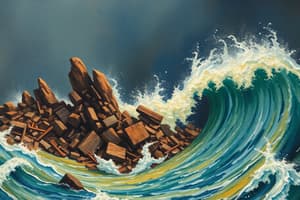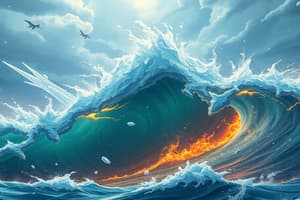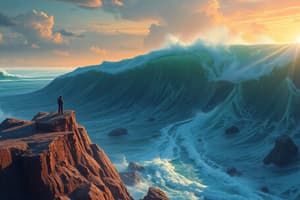Podcast
Questions and Answers
What type of seismic activity was recorded over the nine-day period?
What type of seismic activity was recorded over the nine-day period?
- Slow, constant waves (correct)
- Intermittent bursts
- Pulsating vibrations
- Quick, sharp waves
What triggered the initial seismic signals in the Dickson Fjord?
What triggered the initial seismic signals in the Dickson Fjord?
- A landslide and tsunami (correct)
- Heavy rainfall
- An underwater volcano
- Tectonic plate movement
How much rock and ice was dumped into the fjord as a result of the landslide?
How much rock and ice was dumped into the fjord as a result of the landslide?
- 30 million cubic yards
- 40 million cubic yards
- 33 million cubic yards (correct)
- 50 million cubic yards
What height did the tsunami reach after the landslide?
What height did the tsunami reach after the landslide?
What caused the prolonged seismic activity after the tsunami?
What caused the prolonged seismic activity after the tsunami?
What was the role of the high-resolution sonar survey conducted by the Danish Navy?
What was the role of the high-resolution sonar survey conducted by the Danish Navy?
Where did the landslide occur in relation to the fjord?
Where did the landslide occur in relation to the fjord?
Who led the international team investigating the seismic event?
Who led the international team investigating the seismic event?
Flashcards
The 9-day seismic signal
The 9-day seismic signal
The slow, constant wave that was recorded by earthquake sensors for nine days in 2023, unlike typical earthquake readings which are quick and sharp.
Cause of the 9-day seismic signal
Cause of the 9-day seismic signal
The seismic signal that lasted for nine days was caused by a landslide and the resulting tsunami in the Dickson Fjord in East Greenland.
Scale of the East Greenland landslide
Scale of the East Greenland landslide
The landslide caused about 33 million cubic yards of rock and ice to fall into the Dickson Fjord, triggering a 650-foot-tall tsunami.
Seiche in the Dickson Fjord
Seiche in the Dickson Fjord
Signup and view all the flashcards
Standing wave (seiche)
Standing wave (seiche)
Signup and view all the flashcards
Impact of the seiche
Impact of the seiche
Signup and view all the flashcards
Location of the landslide
Location of the landslide
Signup and view all the flashcards
Scientific methods used to investigate the event
Scientific methods used to investigate the event
Signup and view all the flashcards
Study Notes
Mysterious Global Seismic Event of 2023 Explained
- A slow, sustained seismic wave, lasting nine days in September 2023, puzzled scientists globally. Unlike typical earthquakes, this event exhibited a continuous, unusual pattern.
Origin of the Seismic Rumble
- The epicenter of the event was traced to a landslide in Dickson Fjord, East Greenland.
- A massive landslide on September 16, 2023, involved approximately 33 million cubic yards of rock and ice.
- The landslide triggered a 650-foot-tall tsunami, exceeding recent historical heights.
The Role of the Fjord in the Event
- The narrow geometry of the fjord trapped the mega-tsunami wave, creating a standing wave effect (seiche).
- This standing wave, intensely concentrated in the fjord, reverberated and shook the Earth for nine days.
- The confined space within the fjord prevented the energy of the wave from dissipating. The event's impact was amplified by the fjord's structure.
Connection to Climate Change
- The landslide was a consequence of rising temperatures in Greenland, leading to glacier melt at the mountain base.
- The thinning glacier destabilized the mountainside, causing the collapse.
- Scientists believe this event may represent the initial global impact of climate-driven processes on the Earth's crust.
Studying That Suits You
Use AI to generate personalized quizzes and flashcards to suit your learning preferences.





